More actions
(Created page with "{{Explanatory Guide}}This article aims to provide a comprehensive overview of resistors from a repair perspective, detailing their function, types, common issues, testing methods, and replacement considerations. thumb|Resistor symbols commonly found in schematics (Figure 1) ==What is a resistor?== A resistor is a fundamental electrical component found in every single electronic device and circuit. '''Its role is controlling the flow of elec...") |
No edit summary |
||
| (18 intermediate revisions by 2 users not shown) | |||
| Line 1: | Line 1: | ||
==What is a | {{Explanatory Guide | ||
A resistor is a fundamental electrical component found in every single electronic device and circuit. '''Its role is controlling the flow of electric current within a circuit (limit the current).''' | |Device=Resistors | ||
|Type=Component | |||
|Difficulty=1. Easy | |||
}}This article aims to provide a comprehensive overview of resistors from a repair perspective, detailing their function, types, common issues, testing methods, and replacement considerations. | |||
==What is a Resistor?== | |||
[[File:Resistor symbols.jpg|thumb|Resistor symbols commonly found in schematics (Figure 1)]]A resistor is a fundamental electrical component found in every single electronic device and circuit. '''Its role is controlling the flow of electric current within a circuit (limit the current).''' | |||
Resistors are measured in "Ohms (Ω)" | Resistors are measured in "Ohms (Ω)" | ||
Resistors are typically identified by the symbols shown in Figure 1 and are usually denoted with the letter R followed by an identifier number. (E.g., R381) | |||
== Function == | |||
Even though resistors can only limit the current, they can be used in clever ways -using physical laws- to perform different functions in electrical circuits. Here are a few common ones: | Even though resistors can only limit the current, they can be used in clever ways -using physical laws- to perform different functions in electrical circuits. Here are a few common ones: | ||
| Line 13: | Line 19: | ||
A voltage divider is an electrical circuit that divides a higher input voltage into a lower output voltage using two or more resistors in series. It is commonly used to create reference voltages or reduce voltage levels for specific applications in electronics. | A voltage divider is an electrical circuit that divides a higher input voltage into a lower output voltage using two or more resistors in series. It is commonly used to create reference voltages or reduce voltage levels for specific applications in electronics. | ||
The output voltage is determined by the ratio of the resistance values in the circuit like so:[[File: | The output voltage is determined by the ratio of the resistance values in the circuit like so: | ||
'''Voltage Divider formula (assuming NO LOAD on | [[File:Resistor divider.png|thumb|233x233px|Voltage divider circuit (Figure 2)]] | ||
'''Voltage Divider formula (assuming NO LOAD on V<sub>out</sub>):''' <math>V_\mathrm{out} = \frac{R_2}{R_1+R_2} \cdot V_\mathrm{in}</math> | |||
Uses: | Uses: | ||
* Reference Voltage: Voltage dividers | * Reference Voltage: Voltage dividers can be used to create stable reference voltages for sensor calibration, analog signal processing, and feedback in voltage converters. | ||
* Voltage Scaling: They can be used to scale down high input voltages to levels suitable for analog-to-digital converters (ADCs) or microcontrollers | * Voltage Scaling: They can be used to scale down high input voltages to levels suitable for analog-to-digital converters (ADCs) or microcontrollers. | ||
* Biasing Transistors: Voltage dividers set the base voltage of transistors in amplifier and switching circuits | * Biasing Transistors: Voltage dividers set the base voltage of transistors in amplifier and switching circuits to [[wikipedia:Biasing|"bias"]] the voltage to a certain level. | ||
* Voltage Monitoring: In battery-powered devices, voltage dividers are used to monitor the battery voltage to determine its state of charge. | * Voltage Monitoring: In some battery-powered devices, voltage dividers are used to monitor the battery voltage to determine its state of charge. | ||
* Voltage Regulation: In some cases, voltage dividers are used in conjunction with other components to approximate voltage regulation in simple power supply circuits. | * Voltage Regulation: In some cases, voltage dividers are used in conjunction with other components to approximate voltage regulation in simple power supply circuits. | ||
* And much more | * And much more | ||
| Line 30: | Line 37: | ||
==== Pull-up / Pull-down ==== | ==== Pull-up / Pull-down ==== | ||
Pull-up and pull-down resistors are commonly used in digital electronics to ensure that a digital input signal is in a known state when it's not actively being driven by an external source. They are essential for preventing floating or undefined states | Pull-up and pull-down resistors are commonly used in digital electronics to ensure that a digital input signal is in a known state when it's not actively being driven by an external source. They are essential for preventing floating or undefined states | ||
A pull-up resistor connects a digital input to a voltage level (usually | |||
A pull-up resistor connects a digital input to a voltage level (usually V<sub>cc</sub>, which is the supply voltage). This effectively "pulls up" the input to a logical HIGH state when the switch or sensor is not actively grounding it. Pull-up resistors are often used with switches and sensors that are normally open. When the switch is closed or the sensor is active, it grounds the input, causing it to read as LOW. When the switch is open or the sensor is inactive, the pull-up resistor ensures the input reads as HIGH. | |||
A pull-down resistor connects a digital input to ground (GND). This "pulls down" the input to a logical LOW state when the switch or sensor is not actively driving it HIGH. Pull-down resistors are typically employed with switches and sensors that are normally closed. When the switch is open or the sensor is inactive, it keeps the input grounded (LOW). When the switch is closed or the sensor is active, it drives the input HIGH. | A pull-down resistor connects a digital input to ground (GND). This "pulls down" the input to a logical LOW state when the switch or sensor is not actively driving it HIGH. Pull-down resistors are typically employed with switches and sensors that are normally closed. When the switch is open or the sensor is inactive, it keeps the input grounded (LOW). When the switch is closed or the sensor is active, it drives the input HIGH. | ||
Usually, pullup or pulldown resistors are 2.2k to 10k ohms. | Usually, pullup or pulldown resistors are 2.2k to 10k ohms. | ||
| Line 47: | Line 57: | ||
[https://www.researchgate.net/figure/Current-measurement-with-a-shunt-resistor-and-low-pass-filteradapted-from-14_fig2_221045514 Example and further reading] | [https://www.researchgate.net/figure/Current-measurement-with-a-shunt-resistor-and-low-pass-filteradapted-from-14_fig2_221045514 Example and further reading] | ||
== Types == | |||
=== Fixed value resistors === | |||
These are the most common type and come in various packages, sizes, and materials. | These are the most common type and come in various packages, sizes, and materials. | ||
[[File:Resistor types.png|thumb|192x192px|Different types of resistors (Figure 3)]] | [[File:Resistor types.png|thumb|192x192px|Different types of resistors (Figure 3)]] | ||
=== SMD Fixed value resistors === | |||
SMD (surface mount) resistors are usually black with numbers on top. [https://www.newmatik.com/knowledge-base/KB-EN-00928/resistor-case-sizes They come in different sizes], and there are multiple standards for value marking, most common one is numeric where the last number is the multiplier or "number of zeroes" (for example, 221 on a resistor means 220 ohms). | SMD (surface mount) resistors are usually black with numbers on top. [https://www.newmatik.com/knowledge-base/KB-EN-00928/resistor-case-sizes They come in different sizes], and there are multiple standards for value marking, most common one is numeric where the last number is the multiplier or "number of zeroes" (for example, 221 on a resistor means 220 ohms). | ||
| Line 61: | Line 70: | ||
[https://www.digikey.com/en/resources/conversion-calculators/conversion-calculator-smd-resistor-code Here is an online calculator] for the 3 widely used standards. | [https://www.digikey.com/en/resources/conversion-calculators/conversion-calculator-smd-resistor-code Here is an online calculator] for the 3 widely used standards. | ||
=== THT Fixed value resistors === | |||
THT (Through Hole) resistors are varied in colors and [https://www.electricalengineering.xyz/sheet/resistor-power-rating-chart/ sizes], they usually have [https://www.digikey.com/en/resources/conversion-calculators/conversion-calculator-resistor-color-code colored bands on them to indicate their value]. On ceramic type, the value is written. | THT (Through Hole) resistors are varied in colors and [https://www.electricalengineering.xyz/sheet/resistor-power-rating-chart/ sizes], they usually have [https://www.digikey.com/en/resources/conversion-calculators/conversion-calculator-resistor-color-code colored bands on them to indicate their value]. On ceramic type, the value is written. | ||
=== Variable resistors === | |||
==== Potentiometers ==== | |||
These can be adjusted to change the resistance value, usually with a knob or a screw. | |||
They find applications in volume controls, dimmer switches, and tuning circuits. | |||
==== Thermistors ==== | |||
Thermistors are designed to exhibit a predictable change in resistance in response to changes in temperature, which makes them useful in a wide range of applications, especially in temperature-sensing and temperature-compensation circuits. | |||
There are two common types of thermistors: | |||
==== Negative Temperature Coefficient (NTC) ==== | |||
* NTC thermistors are the most common type. As the temperature increases, their resistance decreases, hence the term "negative temperature coefficient." | |||
* The resistance-temperature relationship of NTC thermistors is nonlinear, meaning that the change in resistance is more significant at some temperature ranges than others. | |||
* NTC thermistors are often used in temperature sensors and temperature compensation circuits or protection circuits. For example, they are found in thermostats, thermometers, and devices that require temperature control. | |||
==== Positive Temperature Coefficient (PTC) ==== | |||
* PTC thermistors exhibit an increase in resistance as the temperature rises, hence the term "positive temperature coefficient." | |||
* The resistance-temperature relationship for PTC thermistors is also nonlinear. | |||
* '''PTC thermistors can be used as self-resetting fuses or current limiters. When they heat up due to excessive current, their resistance increases, reducing the current flow.''' | |||
==== Varistors ==== | |||
A varistor is an electronic component that is used to protect electrical circuits and devices from voltage spikes or transient overvoltage conditions. Varistors are also known as voltage-dependent resistors (VDRs) because their electrical resistance changes with the applied voltage. They are commonly used in various electronic and electrical systems to absorb and dissipate excess voltage, preventing damage to sensitive components. | |||
==== Photoresistors ==== | |||
Also known as Light Dependent Resistors (LDRs), these exhibit changes in resistance based on the intensity of light falling on them. They are used in light-sensitive applications.[[File:Resistor measurement mm.png|thumb|180x180px|Measuring a Resistor (Figure 4)]] | |||
== Testing a Resistor == | |||
'''Make sure the resistor does not have any physical damage such as liquid damage/corrosion first! That's the quickest way of identifying a faulty resistor.''' | |||
Once you have identified the resistor and its specified resistance, you can accurately measure its resistance using a multimeter, as depicted in Figure 4. | |||
'''It's important to note that when measuring a resistor, polarity is not a concern.''' | |||
Ideally, you should measure the resistor outside of the circuit. | |||
* When measuring a resistor within a circuit, the measured value will always be either equal to the ideal resistance or lower. If you happen to measure a resistance higher than the ideal value, this indicates a faulty resistor. | |||
** The reason the resistance of a resistor within a circuit is lower than its ideal value is because you are effectively measuring not only that specific resistor but also everything else connected to it in parallel. '''When resistors are connected in parallel, they collectively reduce the overall resistance.''' | |||
Resistors typically fail in an "open" state, which means they will exhibit a significantly higher resistance than normal or even an open circuit. This is often a result of excessive current causing them to overheat. | |||
Rarely, resistors might exhibit a '''Value Drift.''' Over time, a resistor's resistance value might change due to environmental factors or aging. | |||
[[File:Wirewound resistor.png|thumb|183x183px|Wirewound Resistor (Figure 5)]] | |||
If the original resistance is '''unknown''', you need to compare with a working device or look up a schematic. | |||
On THT wire-wound resistors, it is still possible to determine the resistance even if the markings have worn off or got damaged. To do this, scratch the surface of the resistor in the middle to expose the resistive wire underneath. Then, use a multimeter to measure the resistance from the middle to both ends of the exposed wire. One of the ends will register half of the original resistance, while the other will show an "OL" reading, indicating an open circuit. This method works because when these resistors fail, a break or "cut" occurs somewhere in the resistive wire. That cut can be only in one of the halves. | |||
== Replacement Considerations == | |||
The most important things to keep in mind when replacing a faulty resistor are as follows: | |||
# '''Resistance:''' Choose a replacement resistor with the same resistance value as the faulty one. Keep in mind that there are different tolerances (1,5,10, or 20 percent). Try to stick to 1% if possible. | |||
# '''Power rating:''' Ensure the replacement resistor can handle the same or higher power as the original. If you're unsure of the original resistor's power rating, opt for the highest-rated resistor available in a similar size. | |||
# '''Package size:''' Try to choose a replacement resistor with the same dimensions as the faulty one. If this isn't available and size constraints are not an issue, you can opt for a larger or smaller resistor as long as it matches the power rating, as this will function the exact same way. | |||
[[Category:Repair_Basics| ]] | |||
Latest revision as of 14:28, 17 July 2024
| Resistors - Repair Basics | |
|---|---|
| Type | Component |
| Device(s) | Resistors |
| Difficulty | ◉◌◌◌ Easy |
This article aims to provide a comprehensive overview of resistors from a repair perspective, detailing their function, types, common issues, testing methods, and replacement considerations.
What is a Resistor?
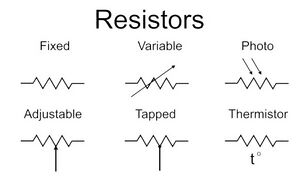
A resistor is a fundamental electrical component found in every single electronic device and circuit. Its role is controlling the flow of electric current within a circuit (limit the current).
Resistors are measured in "Ohms (Ω)"
Resistors are typically identified by the symbols shown in Figure 1 and are usually denoted with the letter R followed by an identifier number. (E.g., R381)
Function
Even though resistors can only limit the current, they can be used in clever ways -using physical laws- to perform different functions in electrical circuits. Here are a few common ones:
Voltage divider
A voltage divider is an electrical circuit that divides a higher input voltage into a lower output voltage using two or more resistors in series. It is commonly used to create reference voltages or reduce voltage levels for specific applications in electronics.
The output voltage is determined by the ratio of the resistance values in the circuit like so:
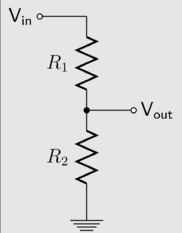
Voltage Divider formula (assuming NO LOAD on Vout):
Uses:
- Reference Voltage: Voltage dividers can be used to create stable reference voltages for sensor calibration, analog signal processing, and feedback in voltage converters.
- Voltage Scaling: They can be used to scale down high input voltages to levels suitable for analog-to-digital converters (ADCs) or microcontrollers.
- Biasing Transistors: Voltage dividers set the base voltage of transistors in amplifier and switching circuits to "bias" the voltage to a certain level.
- Voltage Monitoring: In some battery-powered devices, voltage dividers are used to monitor the battery voltage to determine its state of charge.
- Voltage Regulation: In some cases, voltage dividers are used in conjunction with other components to approximate voltage regulation in simple power supply circuits.
- And much more
Resistor sensors
Resistor sensors, also known as resistive sensors, are a class of sensors that rely on changes in resistance to detect and measure various physical phenomena, such as temperature or light
Pull-up / Pull-down
Pull-up and pull-down resistors are commonly used in digital electronics to ensure that a digital input signal is in a known state when it's not actively being driven by an external source. They are essential for preventing floating or undefined states
A pull-up resistor connects a digital input to a voltage level (usually Vcc, which is the supply voltage). This effectively "pulls up" the input to a logical HIGH state when the switch or sensor is not actively grounding it. Pull-up resistors are often used with switches and sensors that are normally open. When the switch is closed or the sensor is active, it grounds the input, causing it to read as LOW. When the switch is open or the sensor is inactive, the pull-up resistor ensures the input reads as HIGH.
A pull-down resistor connects a digital input to ground (GND). This "pulls down" the input to a logical LOW state when the switch or sensor is not actively driving it HIGH. Pull-down resistors are typically employed with switches and sensors that are normally closed. When the switch is open or the sensor is inactive, it keeps the input grounded (LOW). When the switch is closed or the sensor is active, it drives the input HIGH.
Usually, pullup or pulldown resistors are 2.2k to 10k ohms.
Current measurement
Current measurement using shunt resistors is a widely used method in electronics and electrical engineering to accurately measure the current flowing through a circuit.
The principle behind this technique is Ohm's Law
A low resistance, precise "Shunt" resistor is used in series with the rest of the circuit "load" to measure the current flowing in said circuit by measuring the voltage drop across the shunt. In some cases, the voltage drop is very tiny and needs to be amplified using Op-Amps. In modern electronics, specialized Integrated Circuits "ICs" are used to measure the voltage drop/current draw.
The shunt resistor is specifically designed with a known and well-calibrated resistance value, very close to 0 Ohms, usually 0.002.
Usually, the shunt resistor is placed where a fuse might be, where all the current passes through it. Sometimes, the shunt resistor itself acts as a fuse if a short circuit happens since it will be the highest resistance point in the circuit.
Types
Fixed value resistors
These are the most common type and come in various packages, sizes, and materials.
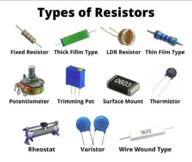
SMD Fixed value resistors
SMD (surface mount) resistors are usually black with numbers on top. They come in different sizes, and there are multiple standards for value marking, most common one is numeric where the last number is the multiplier or "number of zeroes" (for example, 221 on a resistor means 220 ohms).
"R" on SMD resistors means a dot "." (for example 5R60 means 5.60 Ohms)
Here is an online calculator for the 3 widely used standards.
THT Fixed value resistors
THT (Through Hole) resistors are varied in colors and sizes, they usually have colored bands on them to indicate their value. On ceramic type, the value is written.
Variable resistors
Potentiometers
These can be adjusted to change the resistance value, usually with a knob or a screw.
They find applications in volume controls, dimmer switches, and tuning circuits.
Thermistors
Thermistors are designed to exhibit a predictable change in resistance in response to changes in temperature, which makes them useful in a wide range of applications, especially in temperature-sensing and temperature-compensation circuits.
There are two common types of thermistors:
Negative Temperature Coefficient (NTC)
- NTC thermistors are the most common type. As the temperature increases, their resistance decreases, hence the term "negative temperature coefficient."
- The resistance-temperature relationship of NTC thermistors is nonlinear, meaning that the change in resistance is more significant at some temperature ranges than others.
- NTC thermistors are often used in temperature sensors and temperature compensation circuits or protection circuits. For example, they are found in thermostats, thermometers, and devices that require temperature control.
Positive Temperature Coefficient (PTC)
- PTC thermistors exhibit an increase in resistance as the temperature rises, hence the term "positive temperature coefficient."
- The resistance-temperature relationship for PTC thermistors is also nonlinear.
- PTC thermistors can be used as self-resetting fuses or current limiters. When they heat up due to excessive current, their resistance increases, reducing the current flow.
Varistors
A varistor is an electronic component that is used to protect electrical circuits and devices from voltage spikes or transient overvoltage conditions. Varistors are also known as voltage-dependent resistors (VDRs) because their electrical resistance changes with the applied voltage. They are commonly used in various electronic and electrical systems to absorb and dissipate excess voltage, preventing damage to sensitive components.
Photoresistors
Also known as Light Dependent Resistors (LDRs), these exhibit changes in resistance based on the intensity of light falling on them. They are used in light-sensitive applications.
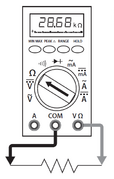
Testing a Resistor
Make sure the resistor does not have any physical damage such as liquid damage/corrosion first! That's the quickest way of identifying a faulty resistor.
Once you have identified the resistor and its specified resistance, you can accurately measure its resistance using a multimeter, as depicted in Figure 4.
It's important to note that when measuring a resistor, polarity is not a concern.
Ideally, you should measure the resistor outside of the circuit.
- When measuring a resistor within a circuit, the measured value will always be either equal to the ideal resistance or lower. If you happen to measure a resistance higher than the ideal value, this indicates a faulty resistor.
- The reason the resistance of a resistor within a circuit is lower than its ideal value is because you are effectively measuring not only that specific resistor but also everything else connected to it in parallel. When resistors are connected in parallel, they collectively reduce the overall resistance.
Resistors typically fail in an "open" state, which means they will exhibit a significantly higher resistance than normal or even an open circuit. This is often a result of excessive current causing them to overheat.
Rarely, resistors might exhibit a Value Drift. Over time, a resistor's resistance value might change due to environmental factors or aging.
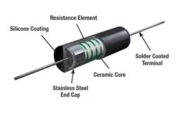
If the original resistance is unknown, you need to compare with a working device or look up a schematic.
On THT wire-wound resistors, it is still possible to determine the resistance even if the markings have worn off or got damaged. To do this, scratch the surface of the resistor in the middle to expose the resistive wire underneath. Then, use a multimeter to measure the resistance from the middle to both ends of the exposed wire. One of the ends will register half of the original resistance, while the other will show an "OL" reading, indicating an open circuit. This method works because when these resistors fail, a break or "cut" occurs somewhere in the resistive wire. That cut can be only in one of the halves.
Replacement Considerations
The most important things to keep in mind when replacing a faulty resistor are as follows:
- Resistance: Choose a replacement resistor with the same resistance value as the faulty one. Keep in mind that there are different tolerances (1,5,10, or 20 percent). Try to stick to 1% if possible.
- Power rating: Ensure the replacement resistor can handle the same or higher power as the original. If you're unsure of the original resistor's power rating, opt for the highest-rated resistor available in a similar size.
- Package size: Try to choose a replacement resistor with the same dimensions as the faulty one. If this isn't available and size constraints are not an issue, you can opt for a larger or smaller resistor as long as it matches the power rating, as this will function the exact same way.


